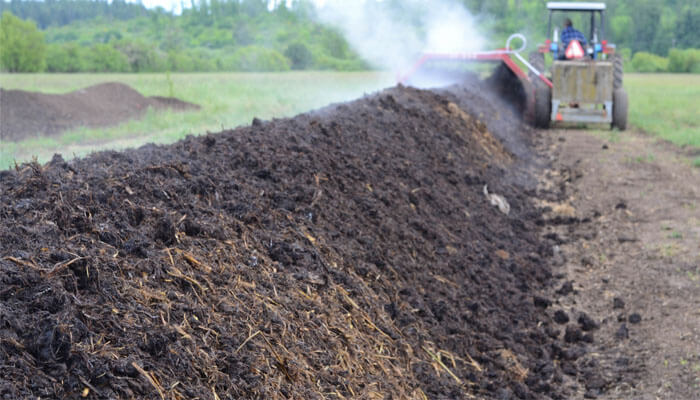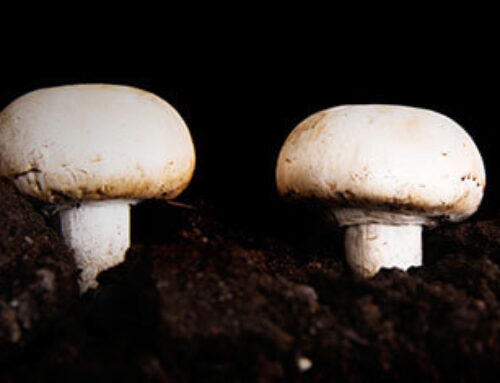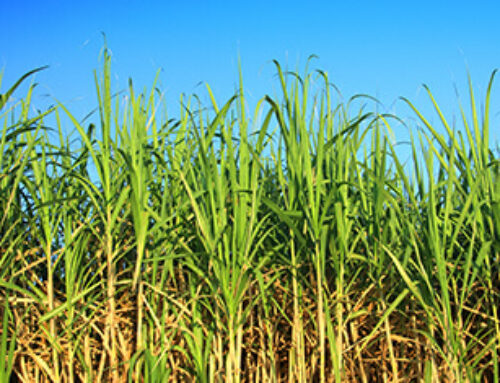
Fermentation of Pig Manure
1. Static Pile:
This fermentation method takes a long time but spends a lower cost. To be specific, blend the pig manure and soil uniformly in an environment of over 15 degrees, and cover the dunghill with plastic cloth, which can accelerate the fermentation speed. The fermentation will be finished if there are steam and white filaments at a certain temperature when opening the cloth on the dunghill after long-time natural decomposition. Then farmers can transport the pig manure to farmland as base fertilizer. By the way, there is no need for this fermentation method to draw support from composting machines, and it’s only suitable for families with low-cost composting production.
Weakness of static pile:
-Decomposition time is long(always taking 4-6 months), or longer if under low temperature, and composting fermentation effect is bad.
-Occupying the site and polluting surroundings because of long-term stacking.
-Dungs through natural composting fermentation are rotten and wet, hard to transfer and apply directly.
-Natural composting fermentation cannot very well eliminate pathogenic bacteria, worm eggs, and other hazardous substances, which can easily cause bacterial infection in plants.
Solution:
Using small composting equipment to turn the material pile and produce a superior pig manure mixture for fertilizing.
Adding a manure leavening agent during the fermentation process accelerates the whole fermentation process.
2. Commercial pig manure windrow composting:
The fermentation of commercial windrow composting must draw support from compost turners, which can not only ensure the quality of material pile-turning but also save whole fermentation time and improve working efficiency. In composting facilities, the most common pile-turning machine is the Full Hydraulic Crawler Type Compost Turner.
Material proportion. Blend the pig manure with straw, sawdust and mushroom residue according to appropriate proportion(manure accounts for 80%-90% while others account for 10%-20%). The proportion is 1t materials (about 2.5t fresh materials) plus 1kg leavening agents, throwing 1kg leavening agents plus 5kg rice bran (or bran, cornflour and other substitution) into materials stack after attenuation, and then mixed fermenting. That is, before mixing, strains need 5 times attenuation with some thinner materials like bran powder or cornflour, beneficial to uniform blending, after the uniform blending of strains and diluting agent, adding them into pig manure and other materials to blend uniformly again. It’s better to add straw or mushroom residue to adjust C:N ratio, which can also avoid nonuniform nutrients caused by a single material. The common carbon-rich materials refer to saw powder, sawdust, manioc waste, bagasse, straw powder, peanut hull powder, rice hull powder, cirrus crushed material, and so on. See more at Compostable Materials Around us.

| Model | XGFD-2300 | XGFD-2600 | XGFD-3000 |
| Width of the pile | 2300mm | 2600mm | 3000mm |
| Height of the pile | 600mm-1000mm | 1000-1300mm | 1300mm-1500mm |
Temperature requirement. Starting temperature should be at least 15 Degree Celsius (available to work at all seasons, free of season effect, trying to make fermentation indoors or within a greenhouse in winter). During the fermentation process, appropriate oxygen supply and turning should be noted, and temperature must be controlled within 55-65 Degree Celsius because too high a temperature will affect the nutrient. When using livestock and poultry manure as raw material, ammonia gas will neutralize some organic acid generated by material decomposition, so it needs to add 5% ground phosphate rock which is very effective to adjust the PH value of materials.
Compost Pile Temperature Reflects the Stage of Compost:
In aerobic composting proper temperature is important. Temperature is a key index for compost. Does the system heat up or not? How long does it keep? How do mixtures affect temperature? All of these are concerned with composting workers.
Heat is generated by the degradation of organisms, so workers can judge the stage of compost and how the decomposition course is going, according to compost temperature. For instance, if compost temperature is up to 40 or 50 Degree Celsius, it can be concluded that compost contains enough nitrogen and water content to support microorganisms growing rapidly.
When monitoring compost temperature, please make sure the thermometer goes deep into the compost for a while, read it after the temperature gets steady, then move it to another new place (including the temperatures at different depth places from the top edge). Sometimes the temperature of compost is high while sometimes is low, mainly depending on the water content and chemical component of compost. Generally, compost temperature change has a certain gradient change rule, for the system with ventilation at the bottom, the position with the highest temperature is about the place 2/3 away from the bottom or higher place.

All temperatures mainly depend on how much heat microorganism generates, and how much heat is lost due to ventilation and surface cooling. While how long the system keeps warm depends on the chemical constituent of compost, and system size and shape. Besides, the water content can also affect temperature change because water specific heat is higher than others, so if with enough water content for microorganism growth, the temperature rising and lowering of a drier mixture will be faster than that of a wetter mixture.
Water content requirement. The water content of fermentation materials should be controlled at around 65%. Too high or too low are both adverse to fermentation because too little water will slow down the fermentation speed while too much water will lead to bad ventilation and slow heating with a foul smell. The ways to adjust materials’ water content show as follows: add a straw, sawdust and mushroom residue into pile when too much water. How to judge water content is appropriate: griping the handful of materials, water stain can be seen but without dropping and the materials disperse once falling to the ground.
Turning piles for ventilation. During the fermentation process, pay attention to oxygen supply and piles turning, starting to turn when the temperature is up to 60 Degree Celsius and doing this once a day, but if the temperature is over 65 Degree Celsius, it needs multiple piles turning. Remember, control the temperature at 65 Degree Celsius because too high a temperature will have a bad effect on nutrients.
Finishing fermentation. With the help of a compost turner, chicken manure compost piles always take about 5 -7 days to finish the deodorization, fermentation of compost and sterilization, etc. The sign of compost: normal pile temperature, black-brown and lose materials, no original foul smell, a little ammonia odor and white hypha. The finished chicken manure organic fertilizers are fluffy with a little winey or earthy taste and rich nutrition, which is more convenient to apply on farmland and a higher value when applied to fruit and vegetables, commercial crops, flowers, and plants. If adding too much sawdust, rice hull, and other auxiliary materials, the fermentation time should be prolonged for sufficient compost.
Mature compost. Direct use to produce commercial organic fertilizer, bio-organic fertilizer, organic-inorganic mixed fertilizer, bio-organic compound fertilizer and so on.
Applicable Materials for Swine Manure Compost Turner Machine
-Kitchen organic waste (swill) treatment.
-Municipal waste and sludge treatment.
-Industrial organic waste (paper mill sludge, sugar refining waste, food processing waste and so on) treatment.
-Agricultural organic waste (fowl dung and livestock manure, oil cake, straw, rice hull, Chinese herbal medicine residue, mushroom residue and fermenting outcome, etc.) treatment.
-Other materials (slaughterhouse residue, sawdust, edible fungi residue, fish waste, biological feed and the like) treatment.
Pig manure mixture for fertilizing is an effective method to process manure with resource, reduction and harmlessness, and maturity is the important criterion for organic fertilizer plant to design, run, control composting process and assess composting products quality.
Quick Links:




